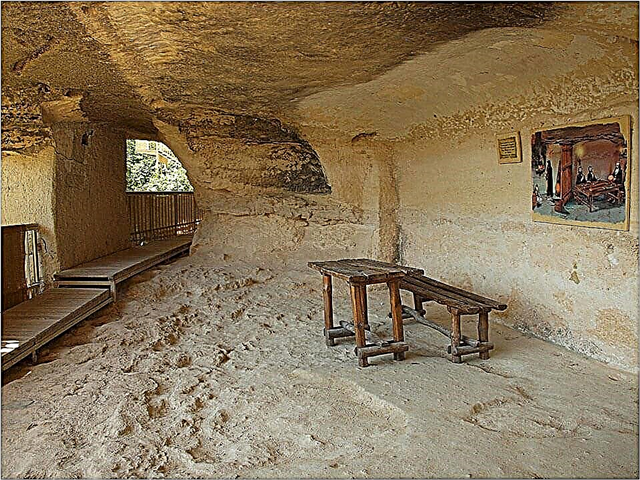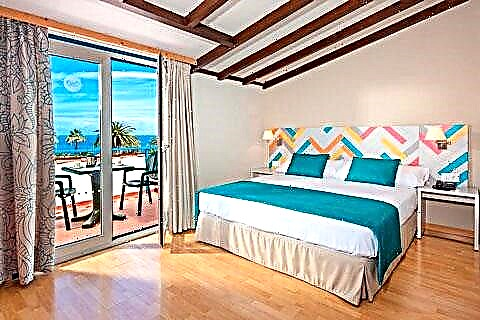Zheleznovodsk is one of the most visited cities in the North Caucasus. Although it occupies a small area, it is one of the most environmentally friendly and actively developing resorts of the Caucasian Mineral Water Resources. There are always a lot of tourists and those who have come to improve their health.
The main asset of Zheleznovodsk is its healing waters. Most of them are concentrated on the Iron Mountain. The pump rooms of the most popular springs - Lermontovsky, Smirnovsky, Slavyanovsky - are installed in the Kurortny Park. In addition to natural attractions, Zheleznovodsk has a lot of human creations. These are monuments, historical buildings, temples. Many of them are also located in the Kurortny Park: the Pushkin Gallery, the Emir's Palace, the building of the Ostrovsky Baths.

The best hotels and hotels at affordable prices.
from 500 rubles / day
What to see and where to go in Zheleznovodsk?
The most interesting and beautiful places for walking. Photos and a short description.
Mount Iron
The main natural attraction of Zheleznovodsk. Has a height of 850 meters. The origin is volcanic. The slopes are covered with dense vegetation. The name comes from the iron-rich mineral springs gushing from the bowels of the mountain. Explored 23 of them. At the foot of the resort there is a spa park where you can drink water from the pump rooms. Also, mineral waters are widely used in city sanatoriums. A 3.5 km route has been laid to the top of Zheleznaya.

Mountains Kabanka, Medovaya and Razvalka
Mountains in the vicinity of Zheleznovodsk. A boar with a height of 760 meters is located 1.5 km from the city and looks like a rock ridge resembling a lying wild boar from the side. Medovaya is located in the south-west of the city, its height is 720 meters. The name is associated with the yellowish color of the rocks, dotted with holes. The breakup has a height of 926 meters and is located 1.5 km north of Zheleznovodsk. Its slopes look like a heap of rubble. All mountains are declared natural monuments, and the remains of ancient settlements have been found on their territory.

Cascade staircase
Since 1935 it has been the main decoration of the Kurort Park, connecting its lower and upper parts. The entire length of the staircase is decorated with flower beds, decorative lanterns, benches, fountains and sculptures of fairy-tale heroes. In the center of the staircase, along its numerous steps, streams of mineral water flow down in cascades, which is not used for its intended purpose. At the very top of the structure, there is an observation deck with stunning views of the city's surroundings.

Palace of the Emir of Bukhara
One of the pearls of the Zheleznovodsk Resort Park is a palace from oriental fairy tales. Built at the beginning of the last century for the emir of the Bukhara Khanate, annexed to Russia. It was presented to the royal family in 1913. The building is light blue and designed in a neo-Moorish style. It is decorated with a ribbed dome and a minaret tower, carved wooden verandas and window frames, a patterned fence and sculptures of lions at the entrance. Today the palace belongs to the local sanatorium.

Lermontovsky source
It is located in the Kurortny Park, 650 meters from the Pushkin Gallery. Monument of nature and history. It was opened in 1810. This is the very first source found on the territory of Zheleznovodsk. The history of the famous resort began with him. In honor of Lermontov it was named in 1964, next to a monument to the poet. The water temperature is + 40 ° С. The pump room pavilion was built in 1916 and looks like a glass rotunda with columns. Inside there are 4 taps with medicinal water.

Slavyanovskiy source
It bears the name of the hydrogeologist Nikolai Slavyanov, who in 1914 drilled a well to a depth of 120 meters and discovered the hottest mineral water in Zheleznovodsk. It has a temperature of + 56 ° C. Used for medicinal baths, bottling and drinking cures. A distinctive feature of the Slavyanovsk spring is the presence of a small amount of radon in it. Water is served in a closed pavilion, built in 1916.

Smirnovsky source
Located at the top of the Cascade Staircase, in the Spa Park. It was discovered, investigated and cleared in 1865 by the famous balneologist Semyon Smirnov, later named after him. Recommended for the treatment of gastric diseases. Subsequently, two more sources were brought to the surface. In 1930, a gallery was built that united all three Smirnovsky springs with temperatures of 37, 40 and 51 ° C. The structure consists of two glass rotundas connected by a suite.

Pushkin gallery
An original openwork construction of metal structures and colored glass, with a silvery dome and 4 small turrets. The opening took place in 1902 on one of the grounds of the Kurortny Park. Since then, the gallery has been a visiting card of the city. One part of it is used for concerts and various cultural events, the second is reserved for an exhibition of works by local artists. A monument to Pushkin is erected in the center. Pushkin square was created nearby.

Ostrovsky baths
The elegant white and red building of a hydropathic establishment in the Arabian style was built at the end of the 19th century. The technical equipment of the baths was at the highest level - mud, hot and cold water were supplied to the rooms through separate pipes, which was a rarity for that time. The complex was named in honor of the brother of the famous playwright, Minister of State Property Mikhail Ostrovsky, an active supporter of the development of the Caucasian Mineral Water Resources. The building is currently being restored.

Sculpture "Eagle"
Eagles are the rightful owners of the mountains, where they have lived and hunted for a long time. Therefore, it is not surprising that this very proud bird is the symbol of the Caucasian Mineral Waters, personifying strength and good health. It can be found here in every resort city. In Zheleznovodsk, a bronze eagle with open wings, strangling a snake with its claws, sits on a pile of stones near the Smirnovsky spring. Another monument to the majestic bird is erected near the Resort Lake.

Sculpture "Signs of the Zodiac"
The original stone sculpture was installed in the Spa Park in 2000. It is a rectangular frame, along the perimeter of which are depicted the signs of the zodiac and animal symbols according to the Chinese calendar. Inside there is a huge solid egg-shaped stone with images of half-naked maidens. The townspeople call the sculptural composition the "egg of desires" and believe that if you turn it around its axis, a cherished dream will come true.

Monument to M. Yu. Lermontov
The picturesque Lermontovsky square with the pump room of the same name and the monument to the Russian poet is a popular recreation place in Zheleznovodsk. The bronze sculpture was installed here in 1988, on the anniversary of the birth of Mikhail Lermontov. The poet stands on a granite block and looks into the distance at his beloved Caucasus Mountains. The nearby flower beds, mighty spruces, ancient lanterns and numerous benches for rest create a very cozy and romantic atmosphere.

Monument to A.S. Pushkin
The main attraction of the Pushkin Square, located next to the gallery of the same name. The 2.5-meter high monument is made of quartz sand, cement, marble chips and rises on a granite pedestal. This is an enlarged copy of the sculpture installed on the 100th anniversary of the poet's death in the Pushkin Gallery. On certain days, literary meetings on the theme of Pushkin's works are held in the park.

Church of the Intercession of the Most Holy Theotokos
In 1917, the first Church of the Intercession was erected in the city, but at the end of the 30s it was completely destroyed.For the construction of the new church, the former building of the mineral baths of 1912 was allocated, which required a global reconstruction. The first service for parishioners took place here in 1996. Today the building is crowned with two domes with crosses, a chapel with a mineral spring is consecrated. Church shops, a carpentry workshop and a library were opened.

Church of the Equal-to-the-Apostles Princess Olga
Located on a small hill, in one of the sleeping areas of Zheleznovodsk. It was built in 1989 on the site of an old temple. It is a white-stone building with gilded domes and windows with colored stained-glass windows. The special pride of the church is the beautiful iconostasis made by local craftsmen using the technique of colored enamel. A belfry was built nearby under a small arch. A church shop, a canteen, and a Sunday school have been opened at the church.

Postal stagecoach station
A small one-story building was built in 1875 at the eastern entrance to Zheleznovodsk. Before the appearance of the first main railway, horse-drawn multi-seat carriages brought here visitors to resorts, mail and luggage. This is the only remaining station on the Caucasian Mineral Waters. The building, together with the courtyard, was transferred to the local history museum, restored and returned to its original appearance. Since 2016, it has hosted an exposition dedicated to Leo Tolstoy.

Museum of local lore
Located near the Lermontov spring. It has been receiving visitors since 1988. Each of the several museum halls has its own theme. There is an archaeological collection, samples of flora and fauna of the Caucasus region, a collection of ancient coins of Russia, things and household items of the first inhabitants of Zheleznovodsk, photographs of famous historical figures. A special place is occupied by an exhibition dedicated to military events.

Train Station
The building was erected at the end of the 19th century and is now declared a protected architectural monument. The old-fashioned platform of the station is equipped with comfortable benches and lanterns. The main railway bypasses Zheleznovodsk, and only one track was laid to the station. Electric trains ran along it to the Beshtau station, without intermediate stops. Since the 2000s, the number of rolling stock has been reduced, and then this direction has been completely closed.

Grotto "Permafrost"
It is located at the foot of the Razvalki mountain, 1.5 km from the city. It was discovered at the beginning of the last century. The peculiarity of the amazing grotto is that even in summer the temperature here is kept at 0 ° C. Its walls are made of petrified magma with large cracks. Through them in winter cold air is sucked in, and in summer it gradually comes out. To study the natural phenomenon, geologists have drilled several adits, one of them is open for sightseers today.

Resort lake
Located at the foot of the Iron Mountain, in the middle of a forest. It was formed in 1954 through the efforts of local residents, who dug a pit on their own, and then filled it with water from a mountain stream. Nowadays it is a popular and comfortable recreation area. The shores of the lake are lined with colored stones, a beach and diving bridges are equipped. Here you can go fishing, take a boat trip or organize a picnic. Nearby there are rides for children, cafes, sports grounds.












